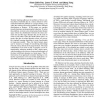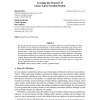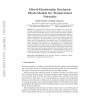38 search results - page 2 / 8 » Relational learning via latent social dimensions |
WWW
2008
ACM
14 years 5 months ago
2008
ACM
Social media such as Web forum often have dense interactions between user and content where network models are often appropriate for analysis. Joint non-negative matrix factorizat...
AAAI
2008
13 years 7 months ago
2008
Transfer learning addresses the problem of how to utilize plenty of labeled data in a source domain to solve related but different problems in a target domain, even when the train...
CIKM
2009
Springer
13 years 11 months ago
2009
Springer
The study of collective behavior is to understand how individuals behave in a social network environment. Oceans of data generated by social media like Facebook, Twitter, Flickr a...
JMLR
2006
13 years 4 months ago
2006
We describe anytime search procedures that (1) find disjoint subsets of recorded variables for which the members of each subset are d-separated by a single common unrecorded cause...
CORR
2010
Springer
12 years 11 months ago
2010
Springer
Abstract: Transactional network data can be thought of as a list of oneto-many communications (e.g., email) between nodes in a social network. Most social network models convert th...



